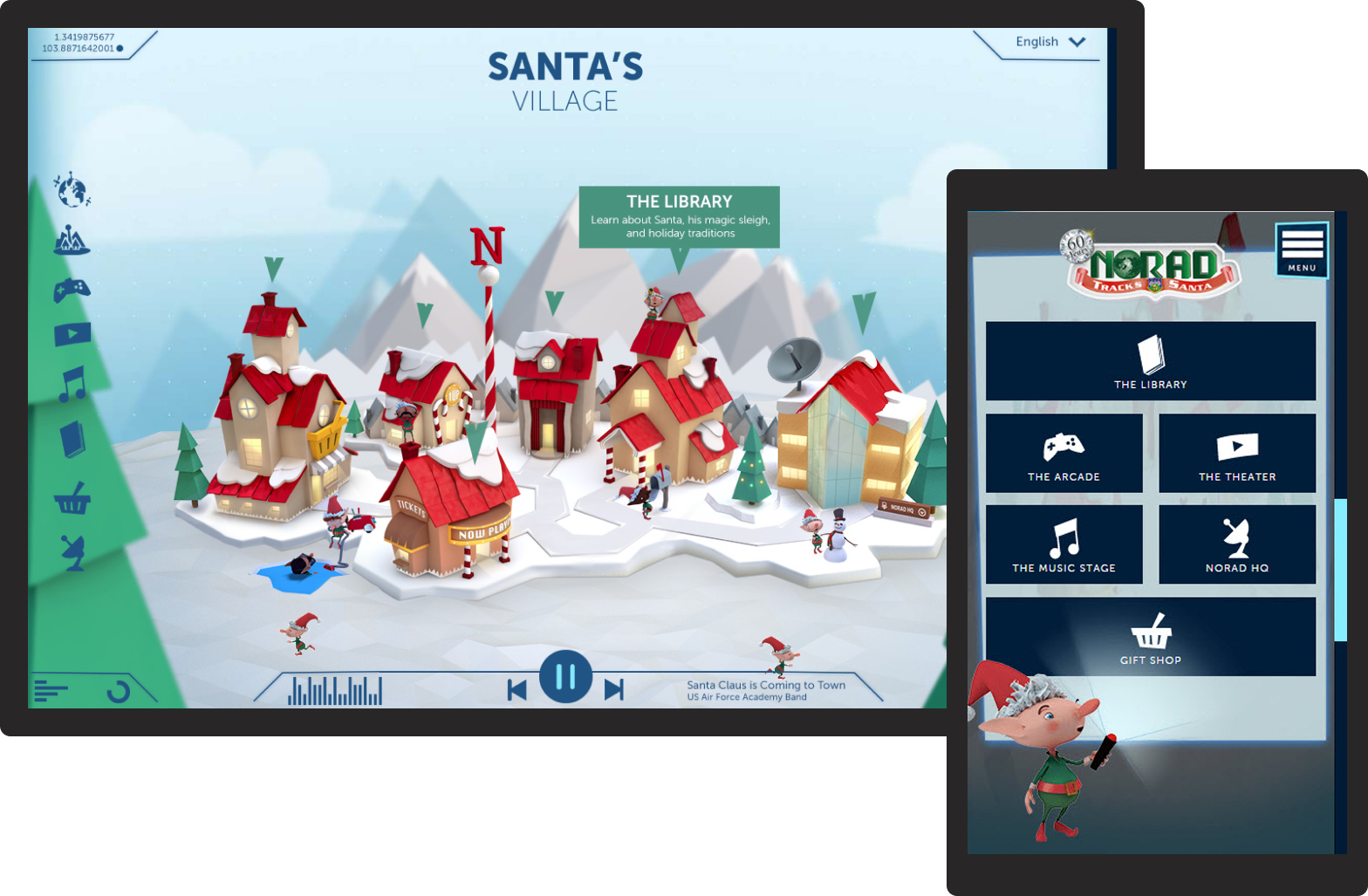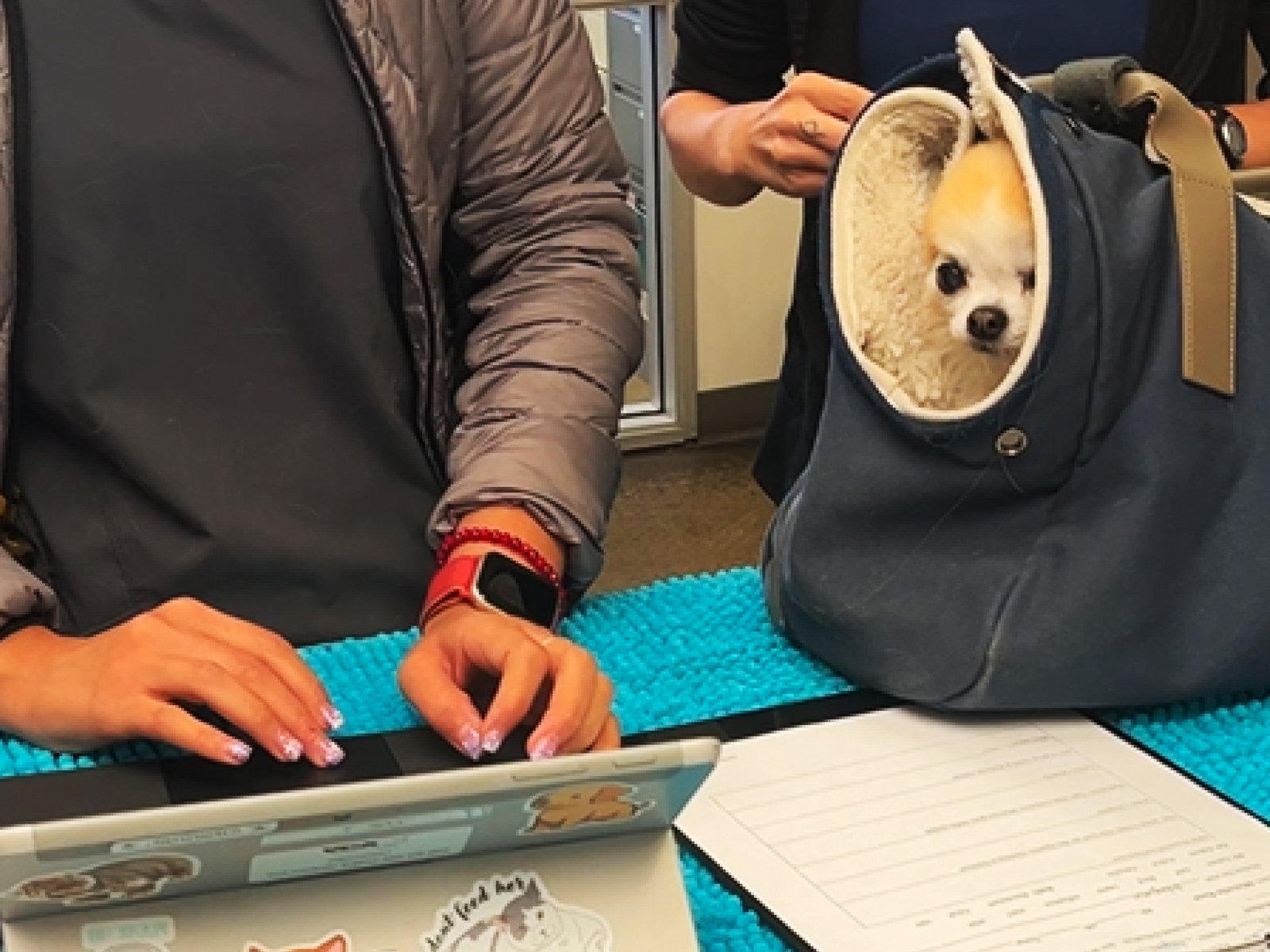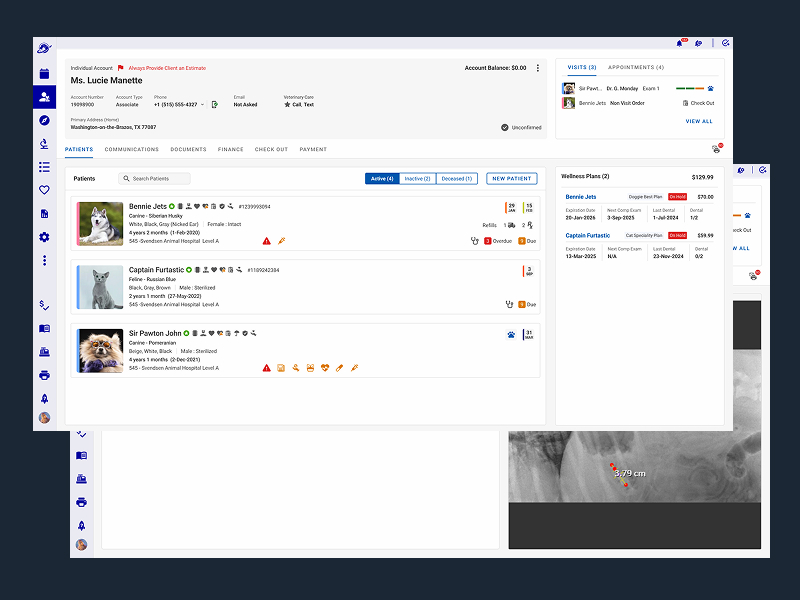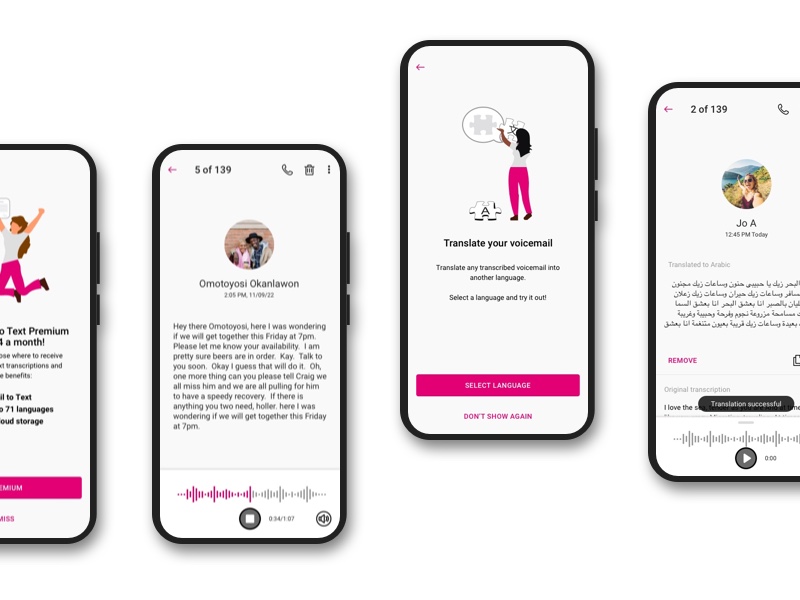Program Summary
NORAD started tracking Santa Claus' worldwide journey in 1955 and wanted a refresh of their classic Santa Tracking Experience with new feature ideas.
Type: Multi-platform Consumer (Pro Bono)
Market: North America • Worldwide (Offered in 8 Langauges)
Team: 1 Technical Product Manager • 1 Visual 3D Artist • 1 Developer • 3 designers
Role: Product Lead - Product Manager • Lead Product and Visual Designer • Lead User Researcher • Front End Developer
Timeframe: 3 Months (Q4) for 4 Years - 2012 to 2016
Challange
NORAD wanted to increase engagement and website traffic during the non-peak times 2-23 December while the website is live. Users (children) did not visit the website except the games and Dec 24 Santa tracking time. The current website looked like an adult website, not one designed for children, so the entire offering needed to be rethought.
Key Metrics
- DAU (Daily Active Users)
- Time to discover website content
- Feature adoption in library and Mission HQ
- Appealing to children by reducing bounce rate
Results
- 15M
increase in visitors in December overall year-over-year - >5 mins
increase time on site and interaction with Library feature - 18%
increase in engagement with website between 2 Dec to 23 Dec from Y1 to Y4 with a 55% decrease in bounce rate. - 2
new social media platform launches that drove engagement an additional 30% to website
Approach
Challenge 1: 3 months to rethink and deliver value in Year 1

In addition to my own design tasks, and later front end development work on the website, I also coordinate receiving or delivering content from NORAD and the various other partners who we worked with.
- Games Partner
- Santa Tracker (Map integration) Partner
- Copy Translation Partner
- 3D Santa and Reindeer Modeling Partner
- Mobile App Development Partner
- My colleagues and myself (creative direction, design systems and branding, Azure hosting, and web development)
Challenge 2: Increasing Engagement Through Understanding the User
"A large part of the public’s perception [of NORAD] seems to derive from the mountain featured in the movie War Games."
The original website my team was tasked to update.
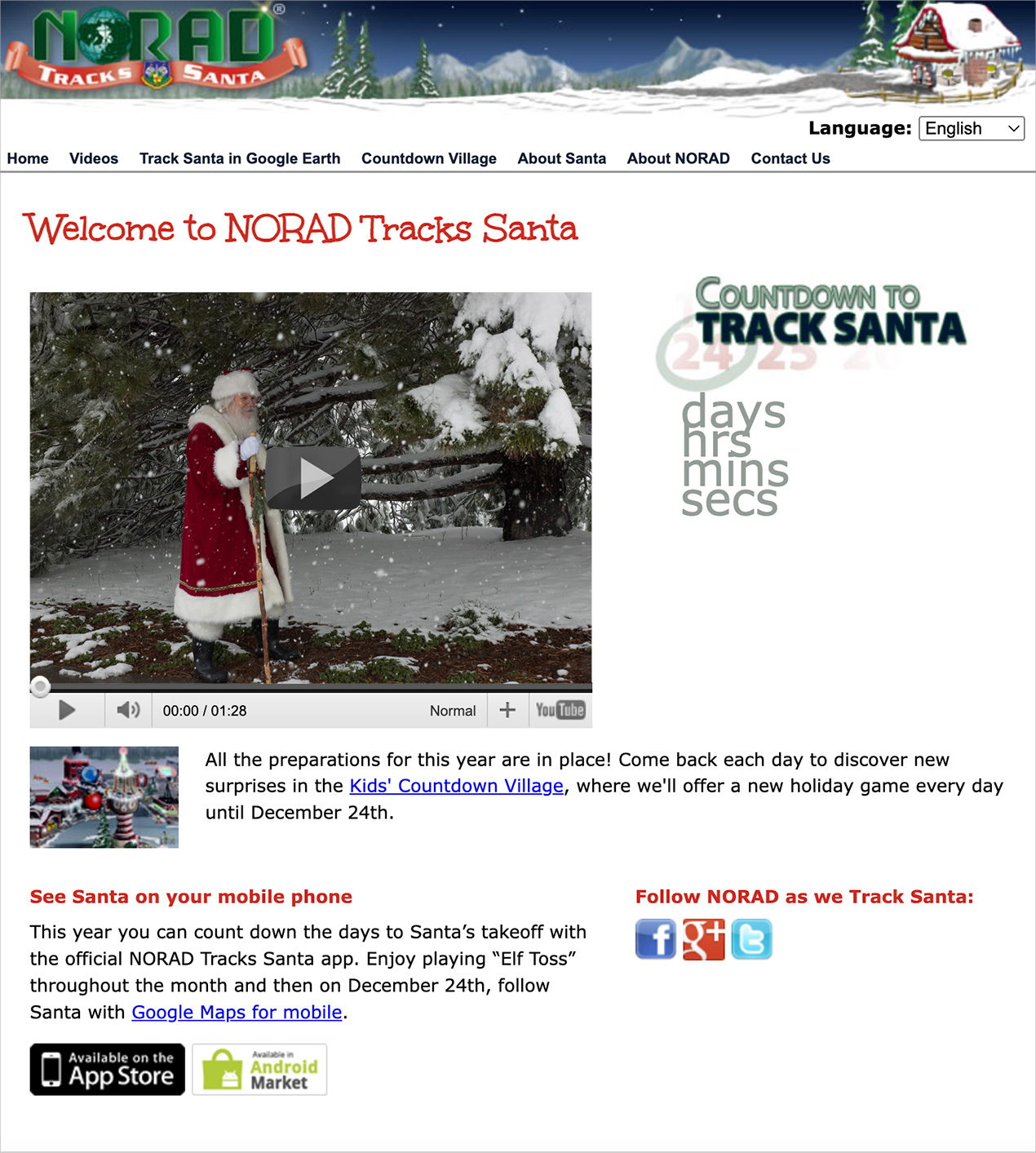
The website accounted for 90% of NORAD Santa Trackers yearly visitors the year we took over the project
Foundational Research: What Do Children "Want?" and What Do Their Guardians Want?
a.k.a. How I was Wrong
Research with parents and children resulted in discovering I targeted the wrong age group. Instead of 8-10 year olds being the age group, it was children 3-5 years.
Research With Kids Through Observation, Interviews, and Play
We invited children and their guardians into the studio to learn more about their digital and social behaviors, preferences, and the adult's actions and concerns.
Observation Methodology
We brought children and their guardians into a room with a couch and observed the children's behavior on an iPad or Computer (their choice) primed with age focused popular digital website brands.
Observation Process
- Prompt the child with the guardians help.
- We took notes from the observations and logged into a spreadsheet
- What grabs the child's attention?
- How long does the child interact with the digital brand?
- Where does the child explore?
- Does the child ask for help?
Interview Methodology
I asked general questions to the child and to the guardian around digital life, sibling life, interests, and thoughts about Santa Claus and Christmas if relevant. In our screener we tried to recruit families who tracked Santa or celebrated Christmas.
Interview Process
- Created baseline interview questions for the study
- Observers took notes from the interviews and we grouped answers and observations into an affinity board
- What is your favorite cartoon character, why do you like them?
- What is your favorite activity on the "brand" website/app?
- What circumstances is the child allowed to use a device?
- Does the child ask for help?
- Does the child use a device with siblings or you?
- What does the child do on NORAD Tracks Santa and for how long?
Key Insights - Kids Make For Memorable Participants
Insight 1
The average age of users (80% Children) is 3 to 4 years old NOT 8 to 10 years old as we originally thought
Insight 2
Children naturally understand technology, but get frustrated and fatigued easily.
Insight 3
Children are instantly attracted to familiar pop culture characters, but will respond positivily to new to them well designed, cute, silly, funny characters.
Insight 4
Children are honest, they will tell us what they don't like, without trying to impress us.
Insight 5
Children expect immediate feedback when they make an action. Colors and sound is non-negotiable.
Insight 6
Adult guardians often don't want to engage with their children on the device, it is a babysitting tool. But they are in favor if an older sibling will engage with the younger sibling on a device, provided it doesn't lead to disagreements amoungst the siblings.
Who Tracks Santa?
Who is tracking and design decisions adhering to COPPA and Data Protection Directive guidelines.
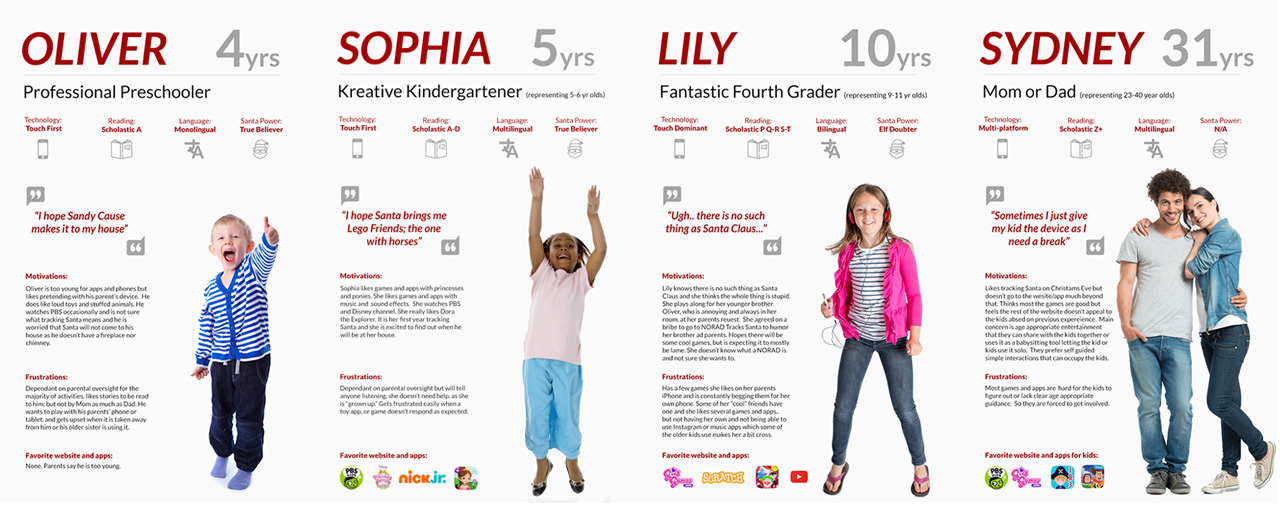
How Do They TRACK Santa?
- Children alone on a device at home or in transit
- Children with active sibling or parent on a device at home
It's Beginning to Look a Lot Like Christmas
Designing for children
Drawing on my previous experience designing kiosks for the Children's Museum of Houston, some background in instructional design and influenced by Debra Gelman and her fantastic book; Design for Kids We were going to bring lots of sound efx, animation, and present small blocks of content in a show don't tell format, well eventually.
Structuring the website
Prioritze a new design and information architecture and set a visual style and language we could build on.
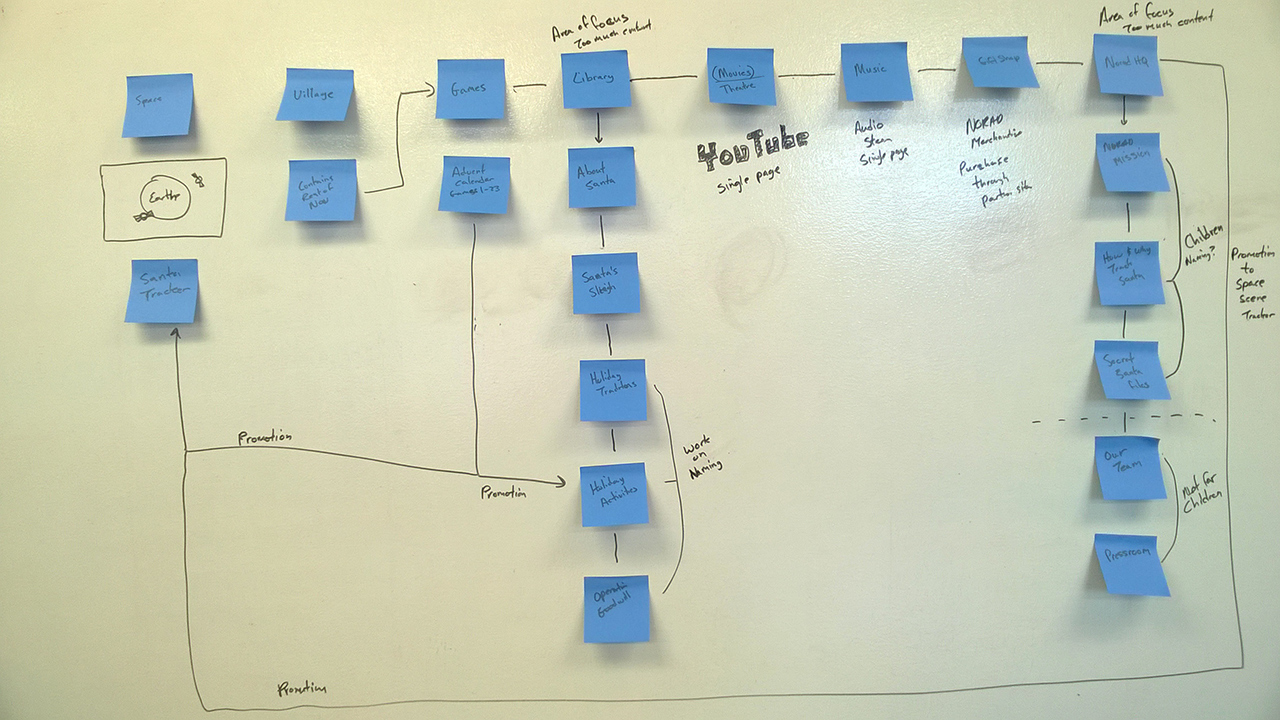
Year 1 Design Solution
We had a severe time constraint given 50% of the team was pulled off of the project.
The wireframes and storyboards drawn by my colleague incorporated a globe filled with interactive Christmas objects that the audience could select to explore different sections of the website. This was also touch friendly for iPad and Surface users.
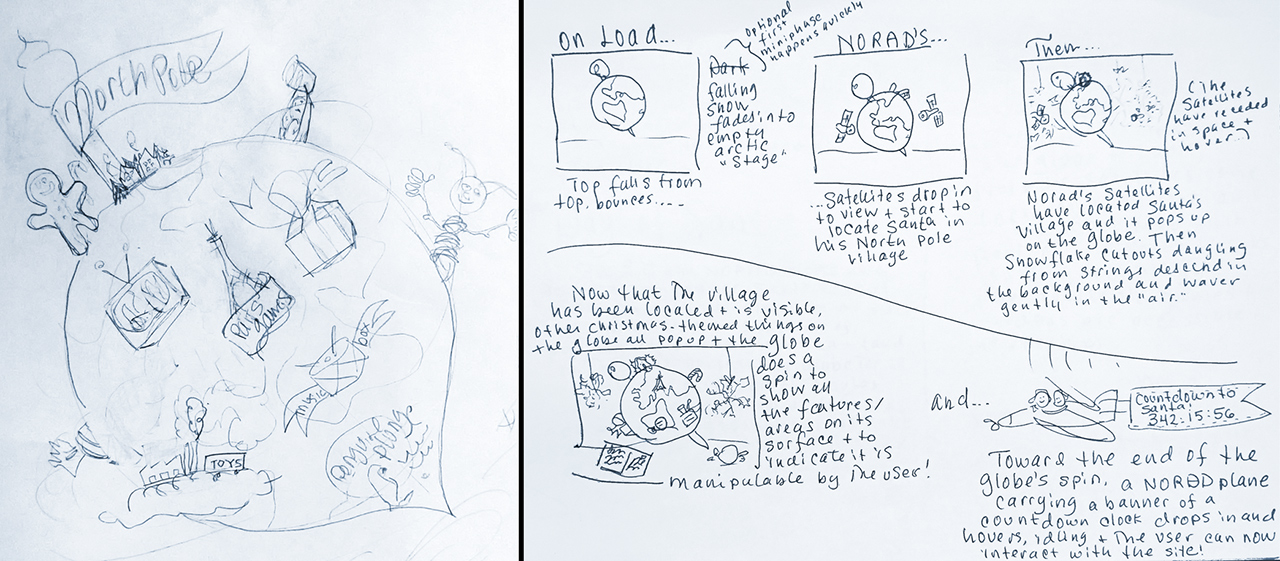
Results
- +290k
increase in visitors in December overall in the first year - +30 sec
increase time on site and interaction with feature area - +80%
increase in engagement with website from Y0 to Y1 with a 90% decrease in bounce rate. - :-(
still low time on site numbers at under 2 mins (not counting 24 Dec)
This design was implemented within 4 weeks and shipped and we were invited back to work on the project the next year. Unfortunately, I don't have the visual designs for this version.
Year 2 Design Solution
New 3D Design and Increased Feature and Visual Engagement (Parallax)
NORAD's Feedback
- Would like emphasis on North Pole Village traditonally a center point of the website. Missing from Y1 design.
- Design that highlited NORAD's everyday mission more.
Challange:
Time on site (not including games) is <2 mins, goal is >5 mins.
Visuals are not favorable with children demographic.
Solution:
Build off of a tripoint strategy of the Globe, Northpole Village, NORAD's mission
The experience will tell a story as the user explores through the site.
Start with Outer Space satellites and globe, then Inner Space with Military Planes, end on the North Pole village
More animated objects, big buttons and interactive elements, more sound efx, like a mad scientist.
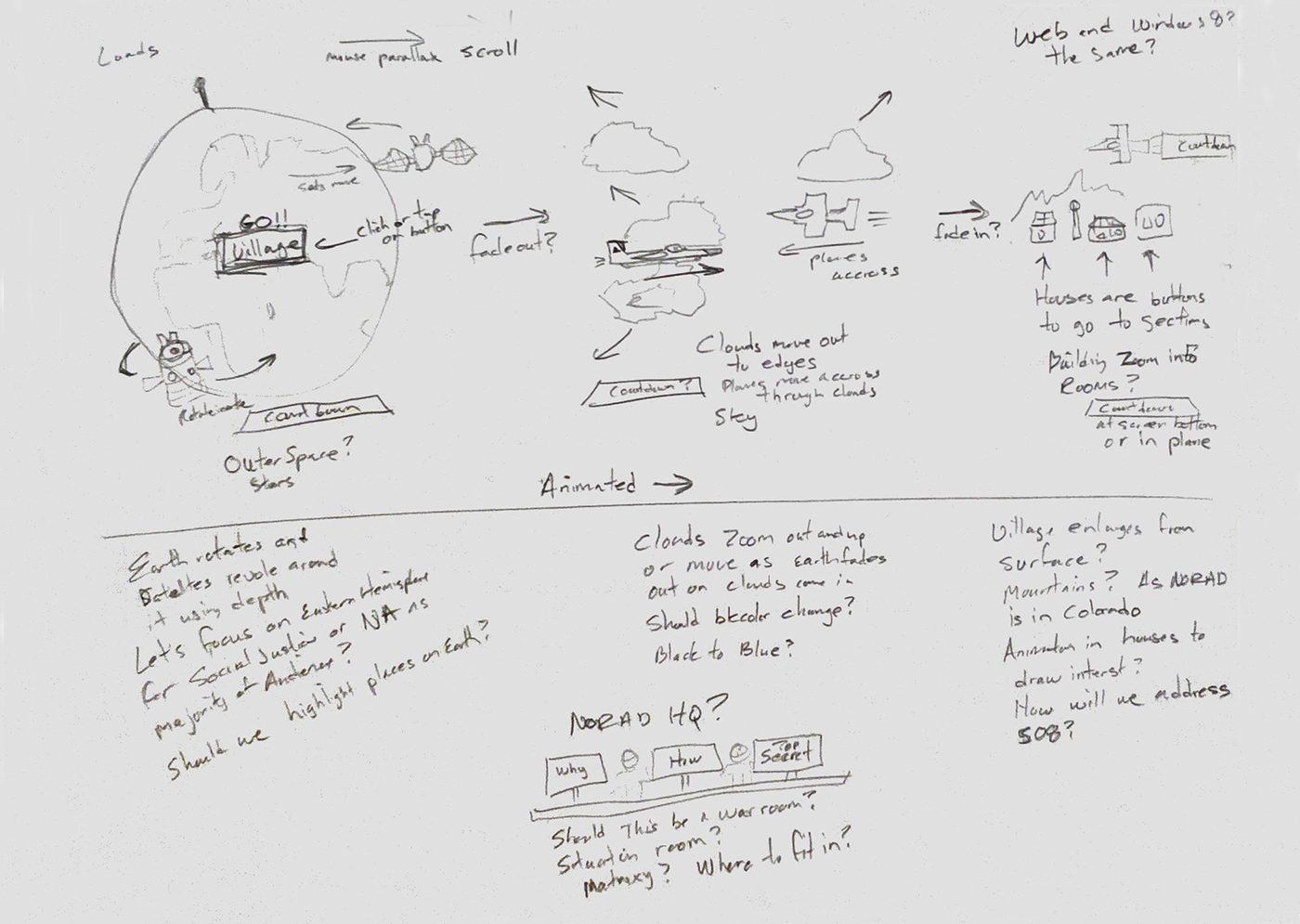
Parallax Website 1st Version
To make the interaction between the sections more engaging; we decided that the website would follow the Parallax model and would use 3D art objects. Digital Kitchen came on as a partner and helped to provide the initial visual 3D modeling of the various sections for us. They suggested a Claymation modeling aesthetic in the style of classic children's Christmas cartoons like the 1964 Rudolph the Red-Nosed Reindeer.
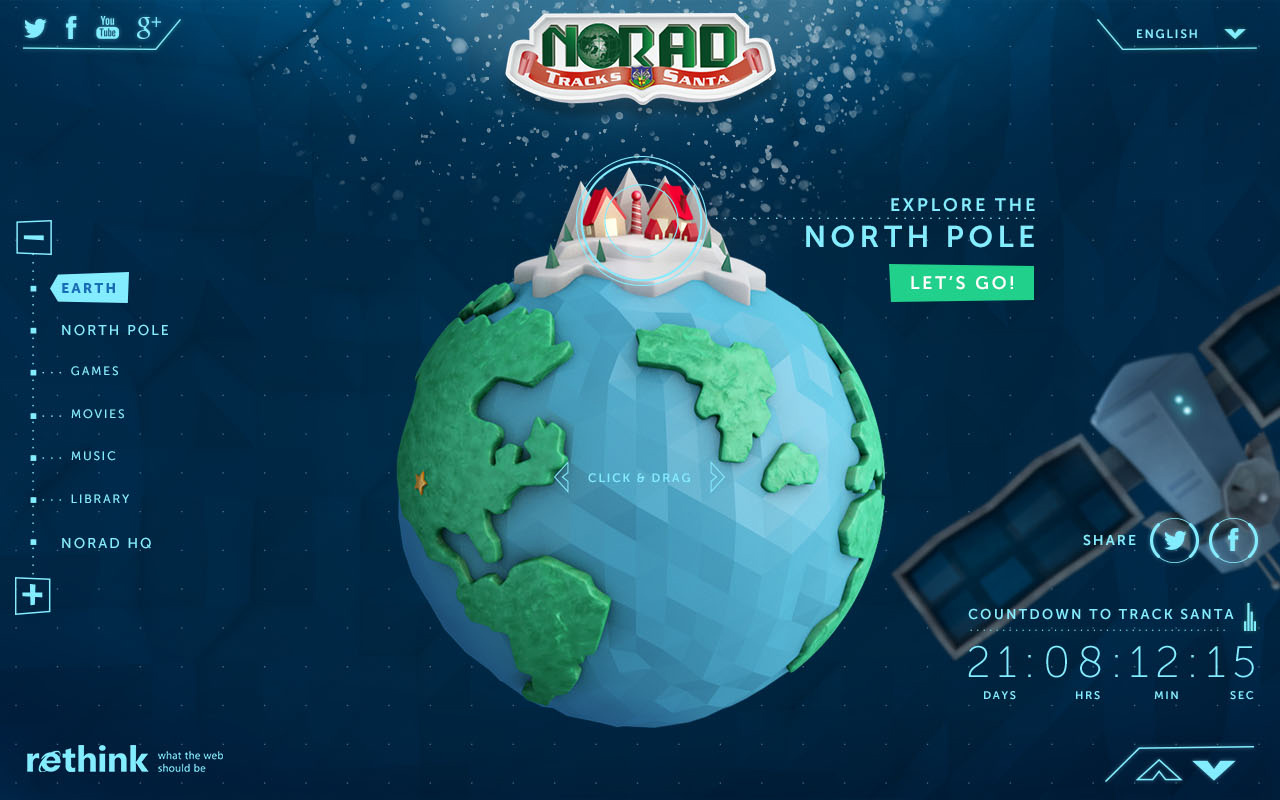
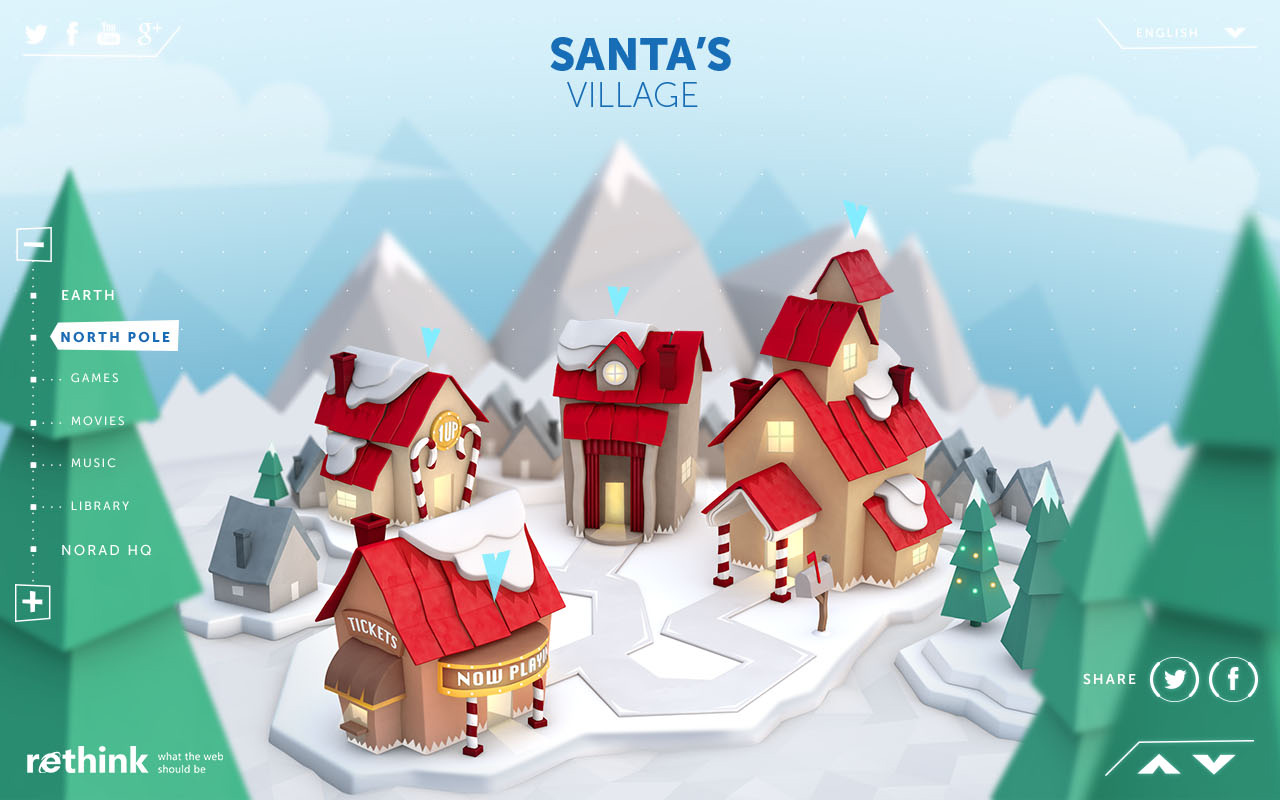
Results
“Mama are they going to shoot down Santa Claus?”
A memorable quote by a child reacting to the military planes visual in the sky.
It became a sort of a mission standard to measure against, all design decisions we made going forward would result in reflecting on this question, does this reenforce the notion that we might be making violence against Sanata Claus?
- +3m
increase in visitors in December overall in the second year - +2 min
increase time on site and interaction with feature area - +30%
increase in engagement with website from Y1 to Y2 with a 40% decrease in bounce rate year over year. - :-(
still low time on site numbers at under 5 mins (not counting 24 Dec)
Year 3 Design Solution
More Visual and Interactive Objects and New Feature Content
NORAD's Feedback
- Drive engagement through metrics for 2 - 23 Dec
- Pitch us feature ideas for children.
- Bring more attention to the NORAD HQ content.
Challange:
Time on site (not including games) is >2 mins, goal is >5 mins.
User feedback: Not enough activities, high bounce rate
Resource constraints: Lost feature team to other projects except: 1 Technical Product Manager, In-house 3D designer, Me
Product constraints: Reduced feature scope ship
Solution:
Roll up my sleeves as a developer
Negotiate successfully with leadership to utilize newly hired 3D designer as a onboarding project
Prioritze Feature Idea List:
- ✅ Expand the Parallax
- ✅ Elves Everywhere
- ✅ Responsive Design and Native Mobile
- ✅ New Social Media Engagement with Instagram and Google+
- 🔴 Iterate on the Library and NORAD HQ
Expanding the Parallax
Outer Space Iterations
- Changed the main text navigation to images. Small children do not or cannot read and they respond better to images and symbols.
- Although we made the globe spin so you could see every continent, no one really discovered this, but they would tap on it. We moved the “Let's Go” CTA onto the globe.
- Redesigned the globe to include missing land masses like the United Kingdom, and more accurately shape the other continents to not offend sensibilities.
- Added music and a music player at the request of NORAD.
- Moved the social media navigation and added new channels (more info in the social media section).
- Added more animations to make the website more interesting.
- Made the navigation and heads up display content change color depending on the background to improve readability and contrast.

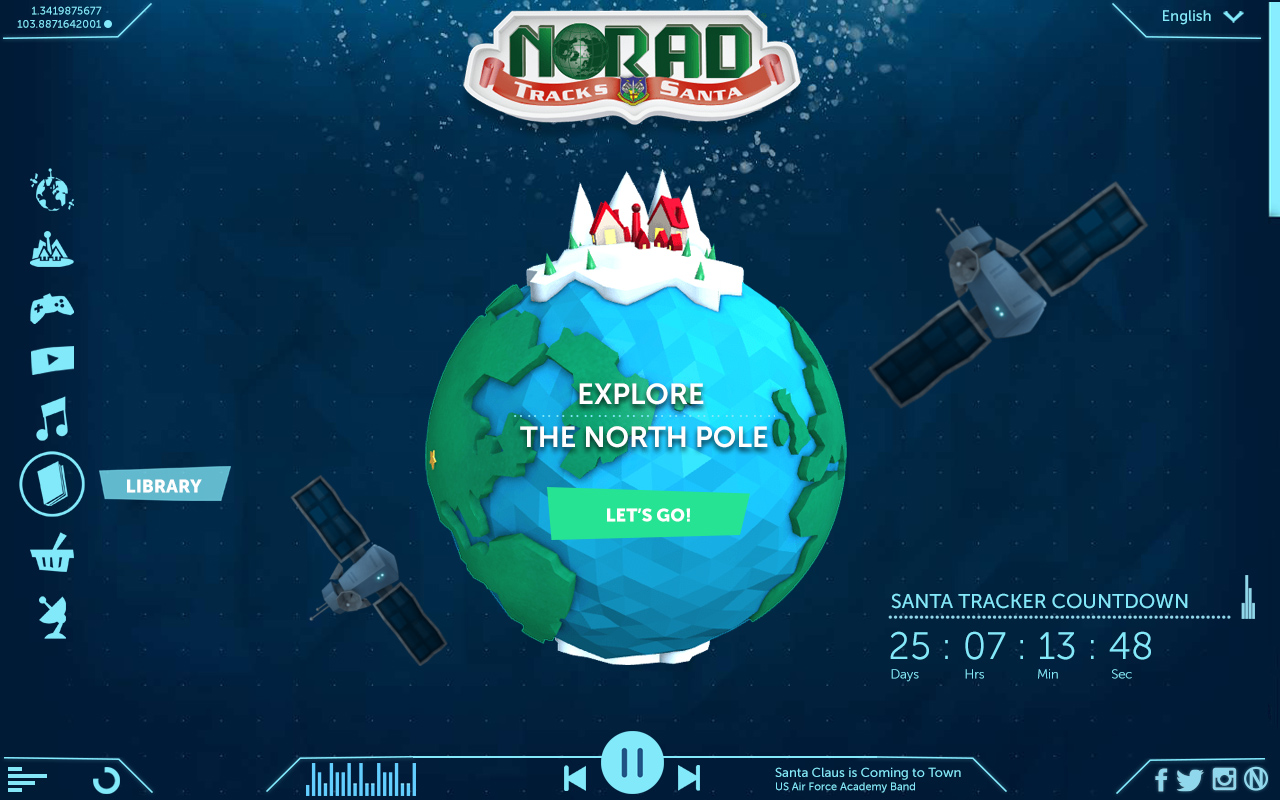
North Pole Village Iterations
- Updated buildings in the village including the NORAD HG building inspired by the actual building in Colorado Springs. Also we added a village Maibaum (Maypole).
- Animated the arrows above the buildings and added content describing what the link is.
- Animated glowing lights to the buildings
- The biggest change to the village and the website at large was the introduction of elves. Animated elves up to elf business and fun. Elves became our avatars to engage children further.


Elves Everywhere: An Elf Life
We wanted to create an avatar that could become real virtually with a name and backstory that our audience would identify and connect with while engaging with the Santa Tracker experience. Thus “Elfie” was born as the first of many elves that would appear around the digital experience.
We worked with NORAD to create a social media campaign and contest to name the elf with the winner announced on both the website and social media through a introduction in mid December.
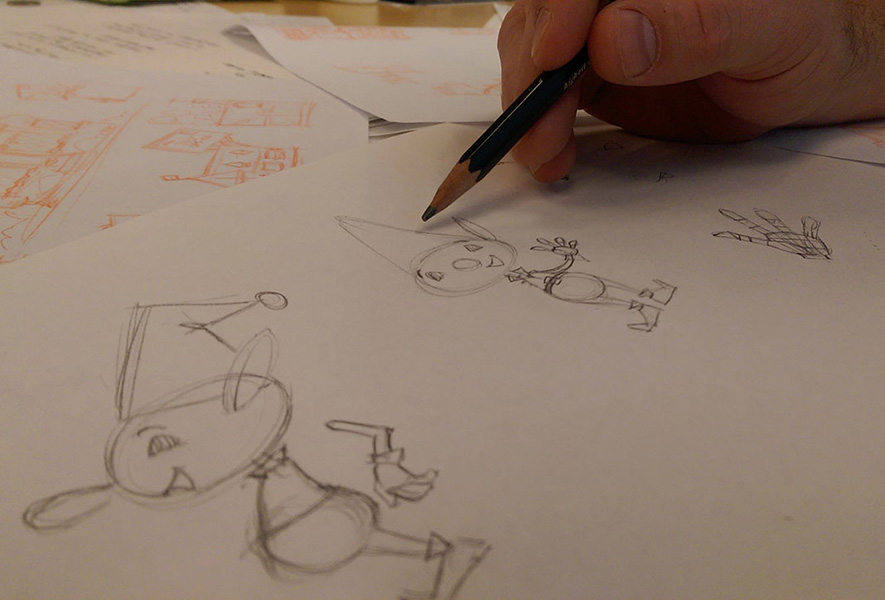
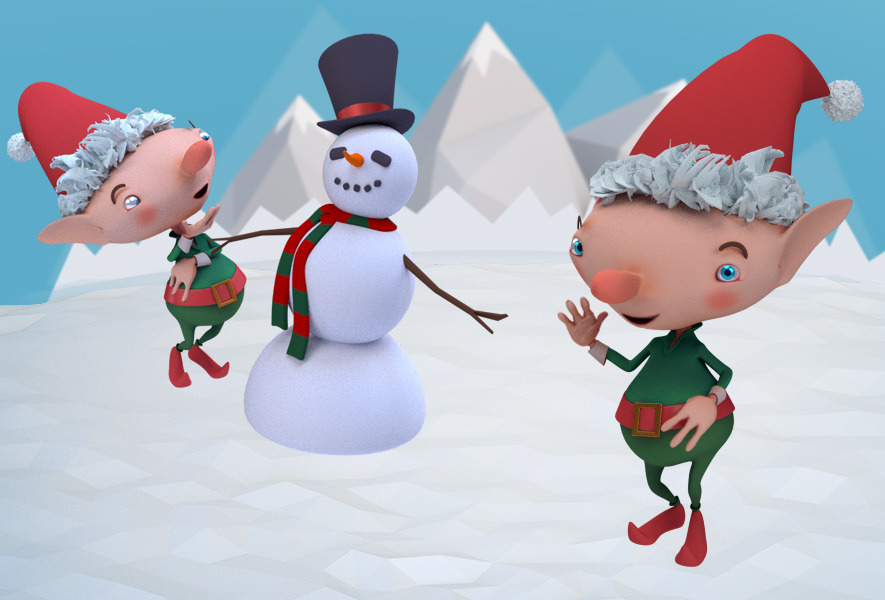
We set about making elves and placing them through out the North Pole village and also on all the subpages of content doing the activities that the children could do in those sections. We also created elves for special events that NORAD could use outside of the website and mobile apps. Here is a sampler of the many elves.

Social Media Engagement
To create more community engagement, we encouraged NORAD to consider adding Instagram, Pinterest, and Google Plus along with their existing Twitter and Facebook accounts to reach a broader audience given Instagram's popularity particularly with younger generations.
Across the platforms we suggested to promote:
- a contest to name “Elfie” the elf
- a contest to explore the website and mobile apps to find other elves where the first x number of people to find them all would get a prize int he form of exclusive content.
- the games as they dropped each day. (We had 23 partner provided games on the website that would unlock each day in December from the 1st to 23rd).
- the activities on the holiday activity page like the interactive coloring pages we created for Microsoft Edge users
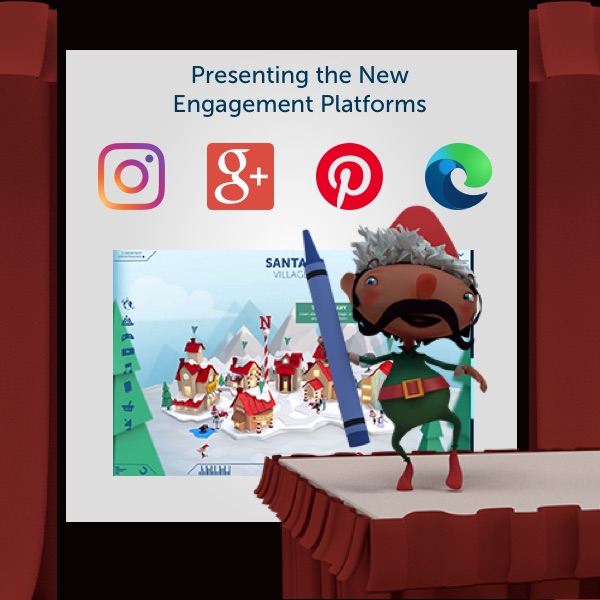
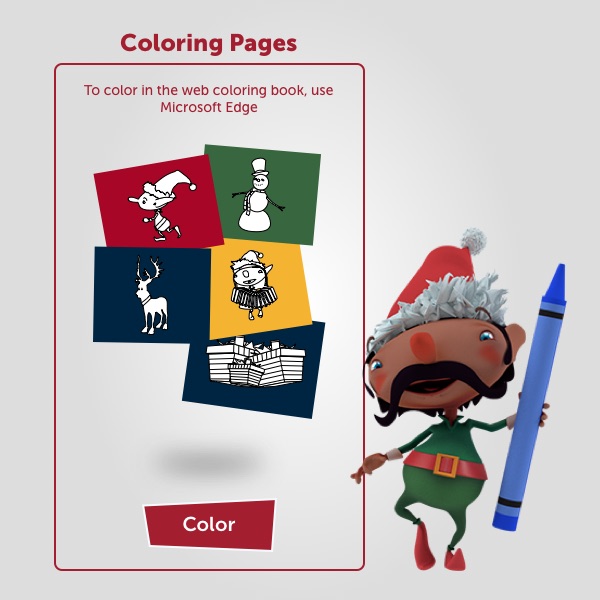
The example of these activities and additions to the website were insturmental in increasing traffic and engagement during December to the Library (Holiday Activities), NORAD HQ, and the Arcade (games page).
Responsive Design and Native Mobile
Responsive design was long overdue especially as our data showed more and more people each year were tracking Santa on smart phones. We also wanted to integrate our current visual language and branding with our native mobile partner.
Mobile visitors accounted for 65% of NORAD Santa Trackers yearly visitors to the website by the third year of the project
While Israel was working on the 3D models, I designed the responsive experience in three phases over the design sprints. The phased approach was to also provide a design system for the Santa tracker and native mobile partners, so they had time to integrate the designs into their respective areas. I used French and German content in the mobile designs for layout and spacing of labels, content, and UI control design.
Phase 1: Outer Space, Inner Space, North Pole Village, and Footer
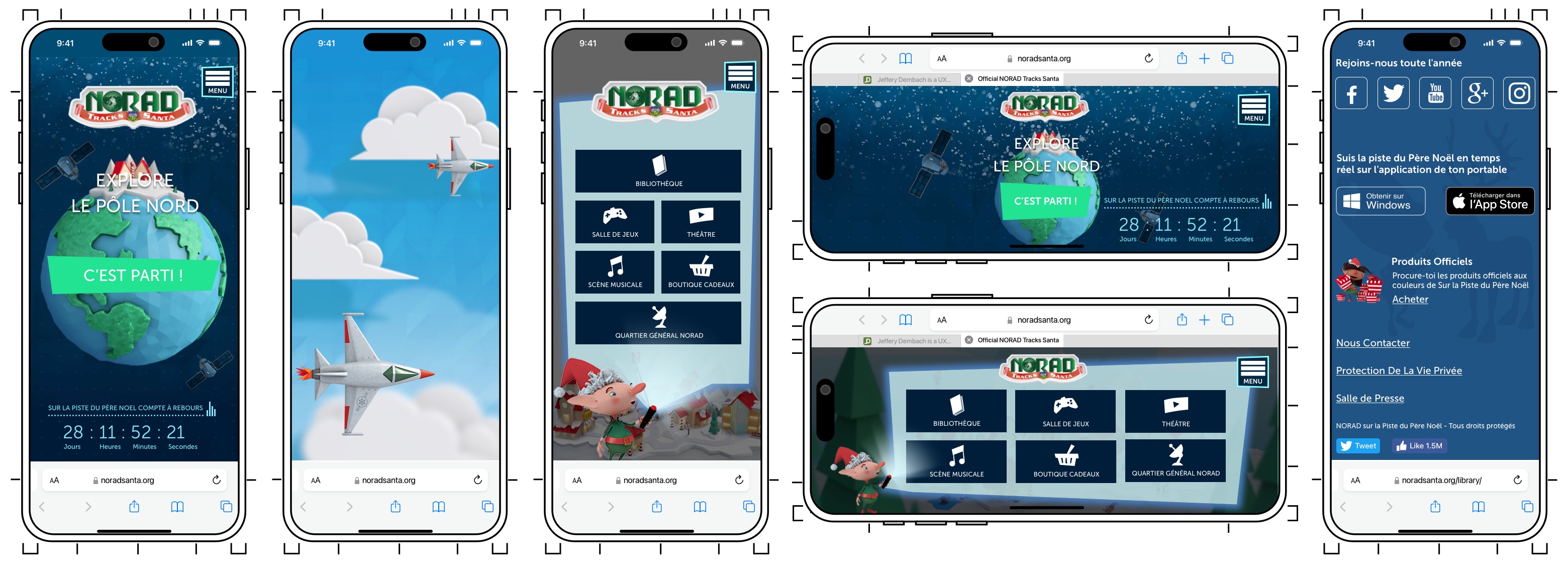
Testing the Mobile Design
In the third year, we conducted another round of usability tests on the website focused on the content improvements to the Library and NORAD Headquarters. In short, we still had a ways to go to optimize the content which I talk about in the Year 4 the section.
We also created some tasks and questions for the responsive mobile design. One of the objectives of the study was to test various icons for the main navigation. Naturally icons would resonate better with children than text labels, so we added this to the rest of the study objectives.
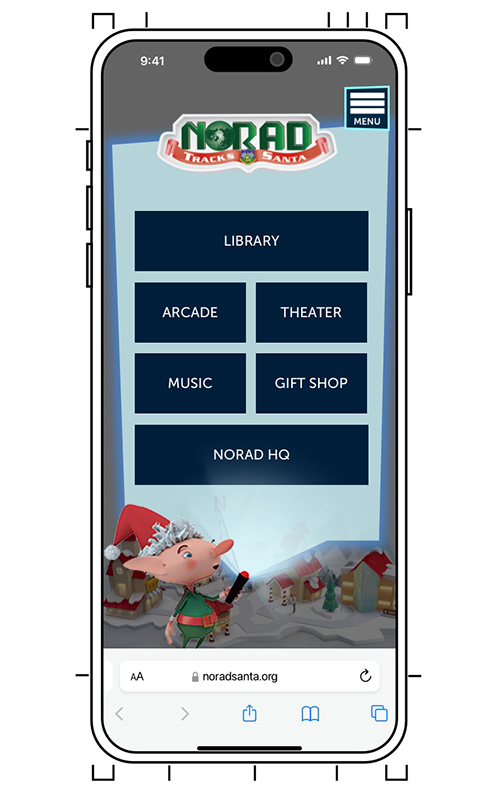
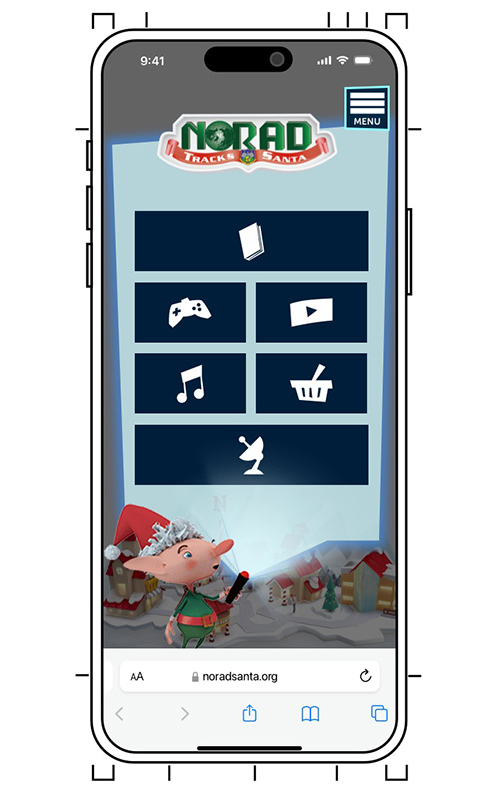
Iterating on the Library and NORAD Headquarters
As time is always a challenge each year, we worked closely with NORAD and Bing to maximize value on the website by pitching our content and design ideas. In our pursuit to move the needle of engagement, a fast win was to add icon and images to every call to action and navigation item as shown in the Library and Headquarters screens.
For the library, Israel and I discussed making the links books rather than just a button with label to increase curiosity and engagement. We wanted to provoke a feeling of home coziness, and shared activities that families do together like read bedtime stories. We decided to draw inspiration and visually theme the books in the spirit of “Little Golden Books” that I read and collected as a child.
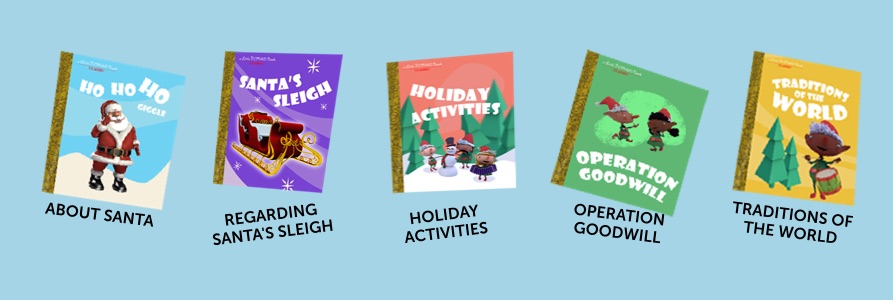
In year 3, we added a new section of content about different holiday traditions around the world working with NORAD on regions and traditions that they wanted to highlight. This also helped us with a secondary business goal of driving search traffic to Bing and increasing engagement. We accomplished this by using Bing maps and geotagging the regions for the holiday traditions and adding a call to action to learn more about the festival, religious celebration, and region through a link to Bing’s search engine.
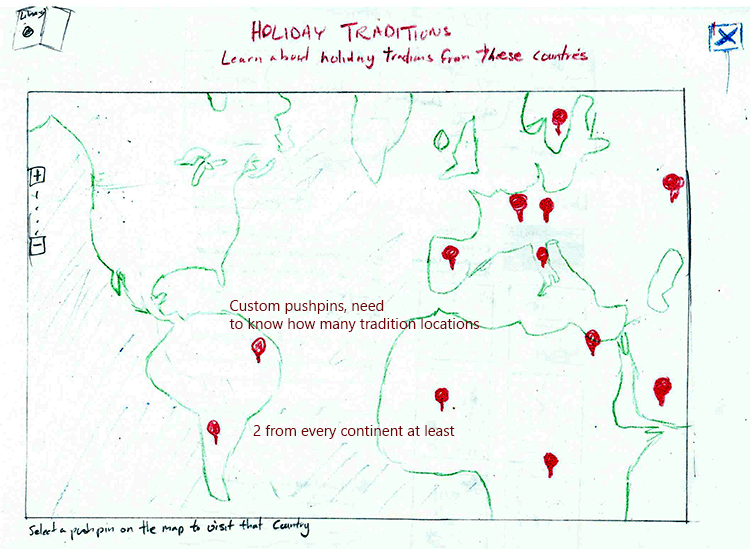
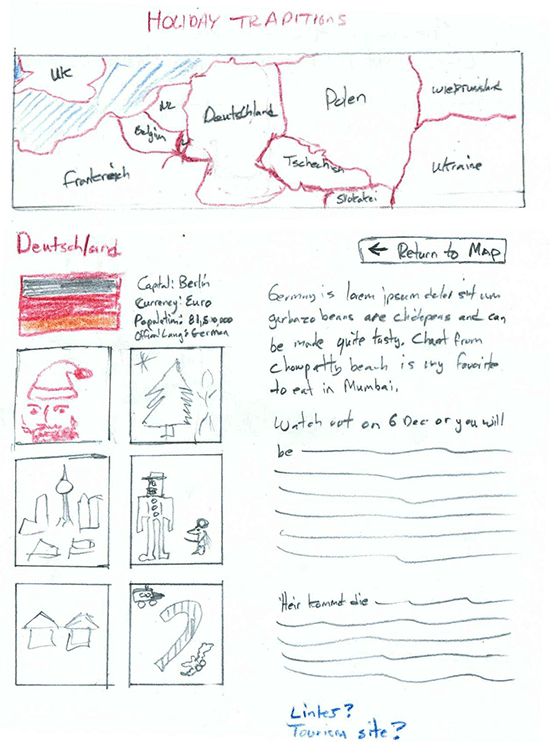
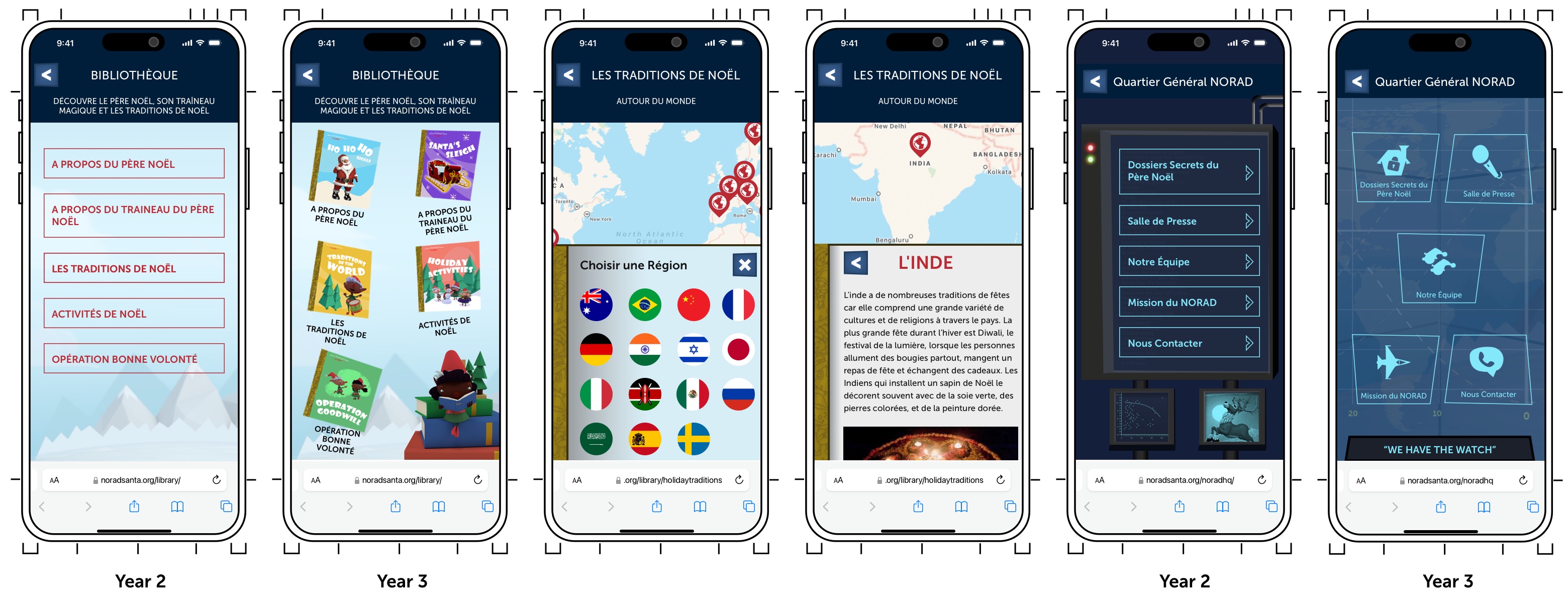
Results
We made a bigger impact in the third year despite less resources. I attribute this to the amazing work the team did in year 2 setting up a solid foundation particualry with the front end coding and animation of the website.
- +4.7m
increase in visitors in December overall in the third year - +6 min
increase time on site and interaction with new feature areas - +45%
increase in engagement in terms of page views from Y2 to Y3 with a 20% decrease in bounce rate year over year. - 2
new social media channels launched driving +32% of unique visitors to website
Year 4 Design Solution (Final Year for Me)
Increasing Engagement With the Content and Gamifying the Christmas Experience
NORAD's Feedback
- Site experience is exceeding expectations
- Pitch us more feature ideas for children.
- Address strategic partner's requests
Challange:
Increase metrics for Holiday Traditions with new features
User feedback: Increase langauge support
User feedback: Holiday Traditions while interesting don't hold users attention.
Partner feedback:Increase traffic to Bing specificaly on 24 Dec Santa Tracking event.
Solution:
- 🔴 Expand Language Support
- ✅ Increase Holiday Tradition Engagement through gamification
- ✅ New Social Media Engagement with Instagram and Newsroom, Depreciated Google+ due to lack of overall platfom user engagement
- ✅ Drive traffic to Bing from Santa Tracker (strategic partners request)
Expanding Language Support
I proposed increasing language support to Arabic, Hindi, and Russian. To reflect the included holiday traditions, changing USA demographics, and user feedback.
However, reviewing site analytics of visits by region we placed this feature into the backlog.
Improving the Holiday Traditions
Traditions Around the World analytics showed a high visit rate, but also a high bounce rate. Positive comments in social media, had proven this was a visible feature, thus an important feature for NORAD. To increase engagement I proposed turning the feature into a game.
The user would help one of our elves locate the traditions by associated region gain a point for each correct match.

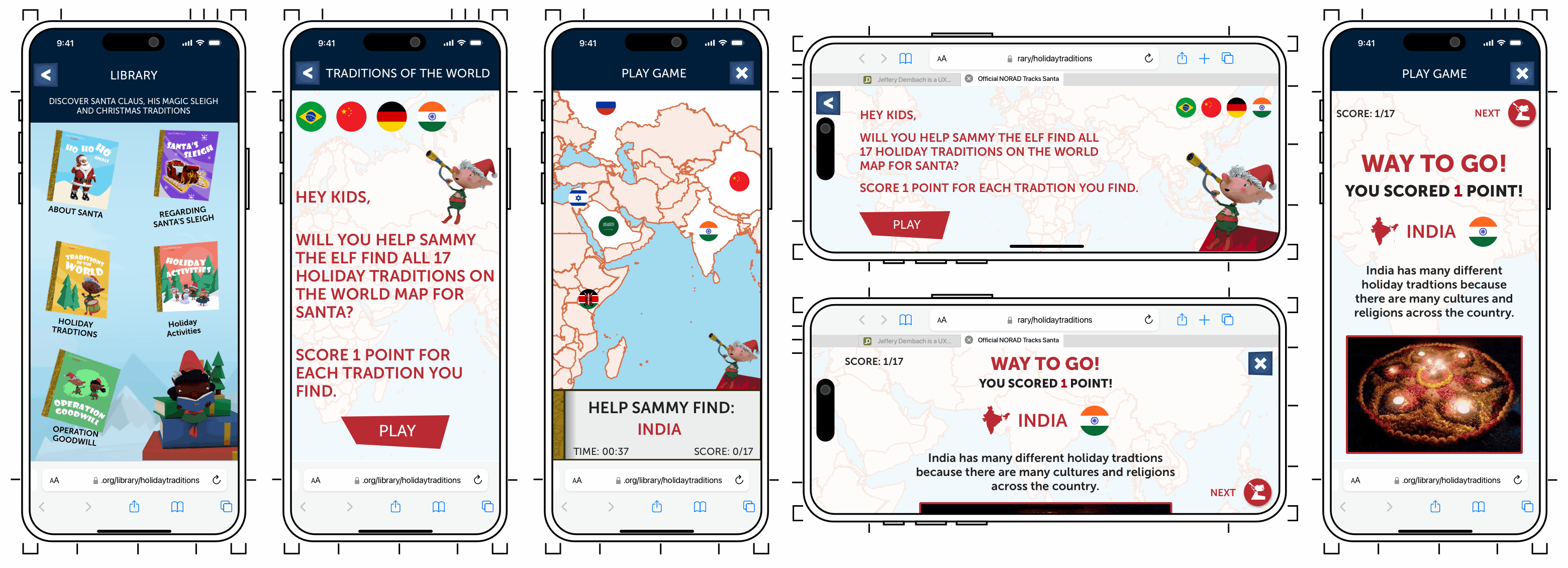
Adding to the Santa Tracking Experience (strategic partners request)
One of the design challenges with the Santa Tracker experience I was asked to solve for in year 4 was to create additional content that would help drive more engagement to Bingon the Santa Tracker screen. What made it more interesting is that it was an late unplanned in the season request by Microsoft. In my feature and design solution I had two constraints to consider. The first was not taking away from the Santa tracking experience or confuse our audience with possibly unrelated content. The second was how to fit this content into a small form factor of a mobile phone, particularly in the landscape orientation viewport.
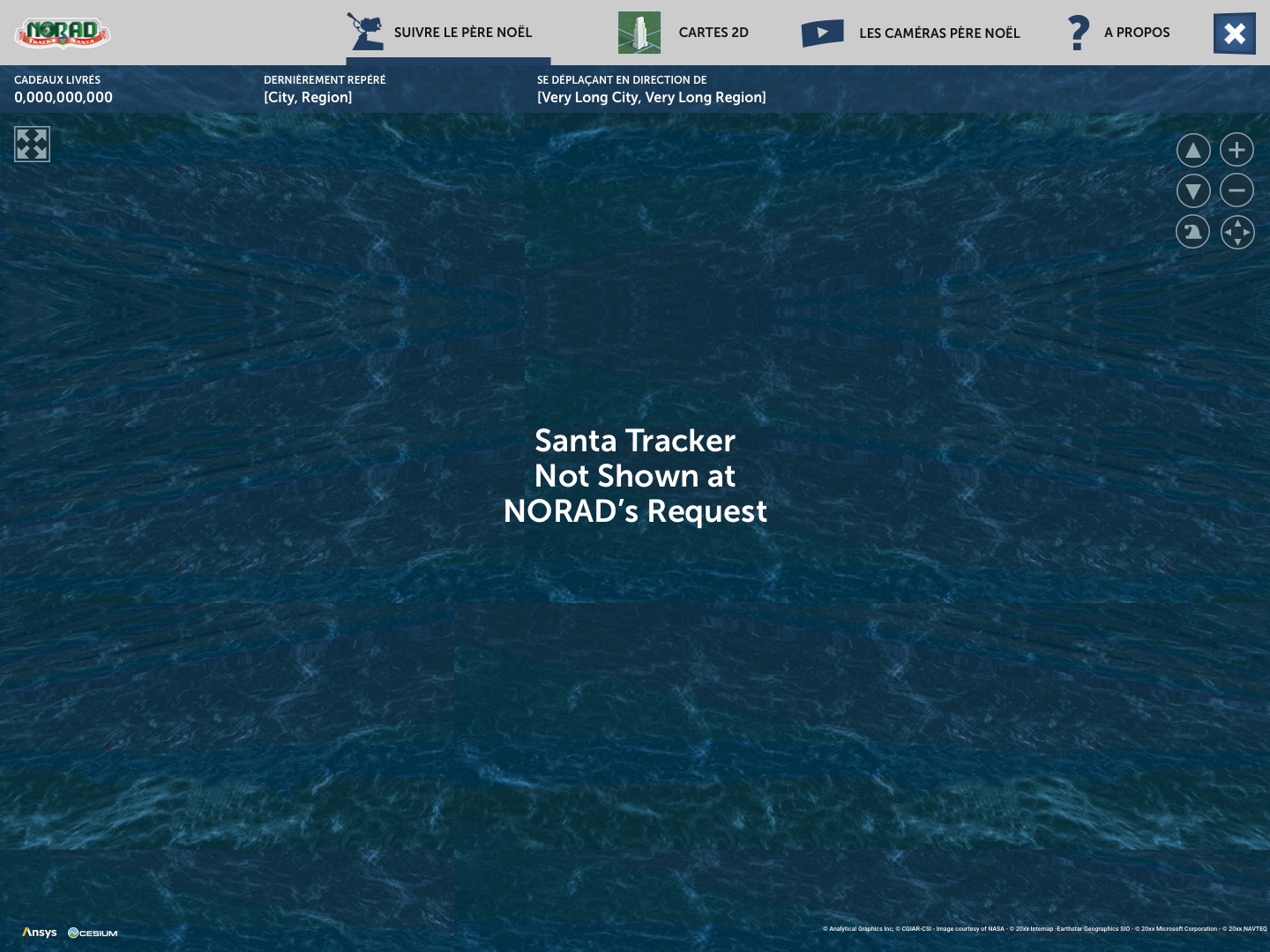
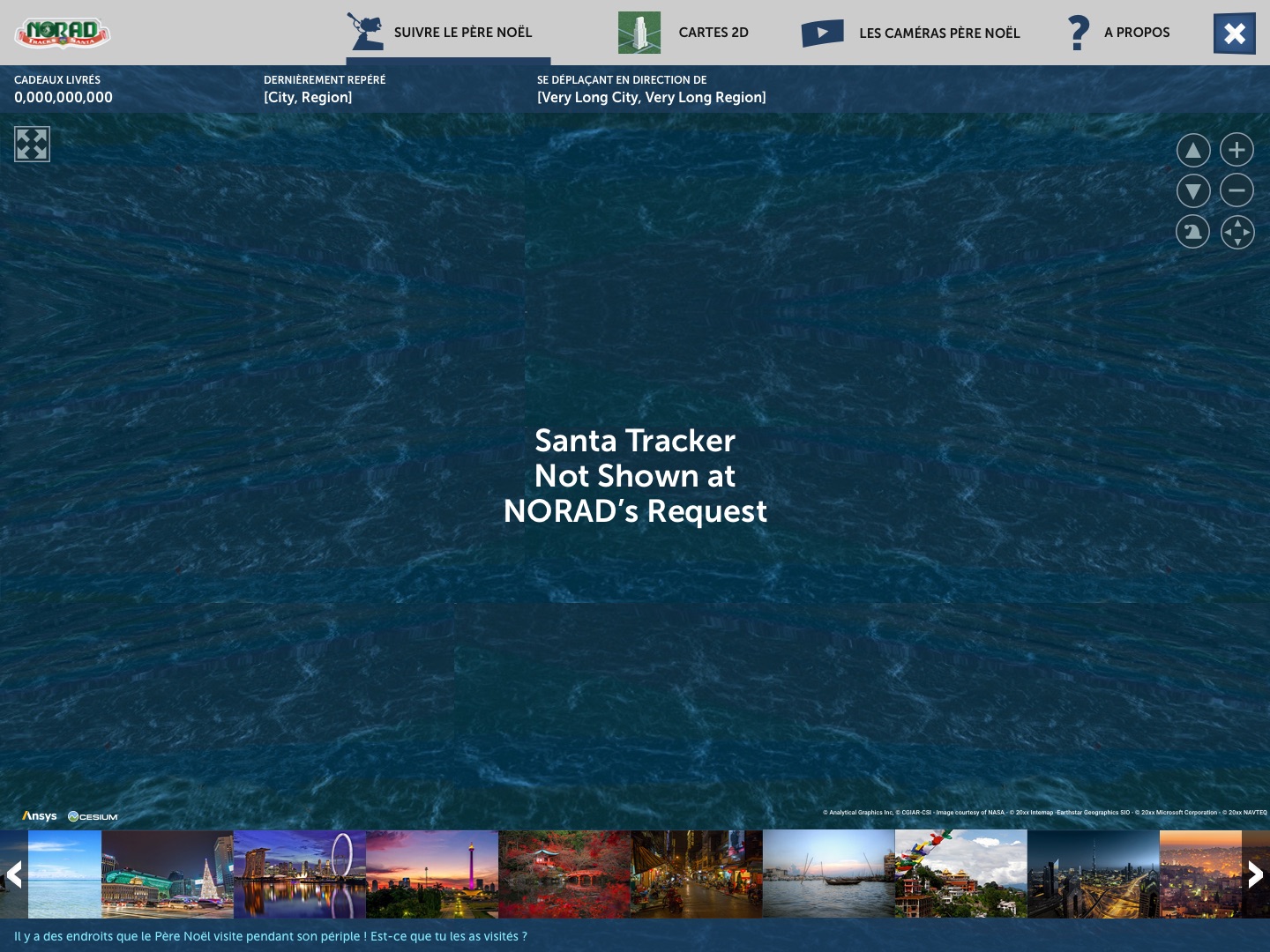
My solution was threefold:
The first involved creating a seamless integration by creating a photo carousel of places Santa visited and prompted the call to action to select an image by asking if the audience had visited there as well. Naturally, this was considered for older children or adults as was outside our primary audience of preschoolers who can’t read and would not select an image, unless by accident.
The second was a way to get the user back to the Santa Tracker from Bing without the need to use the browser back button. This was accomplished this with an iframe for the desktop web and mobile web experience.
The third solution, considering the mobile landscape form factor and area the photo carousel with the tracking stats would occupy, I added a control bar to swipe to show and hide the carousel container. This design solution was agreed upon by the stakeholders, and according to the analytics it was popular as 93% of our users selected more than 1 photo and swiped horizontally through the complete carousel. I intended to further design explorations the following year.
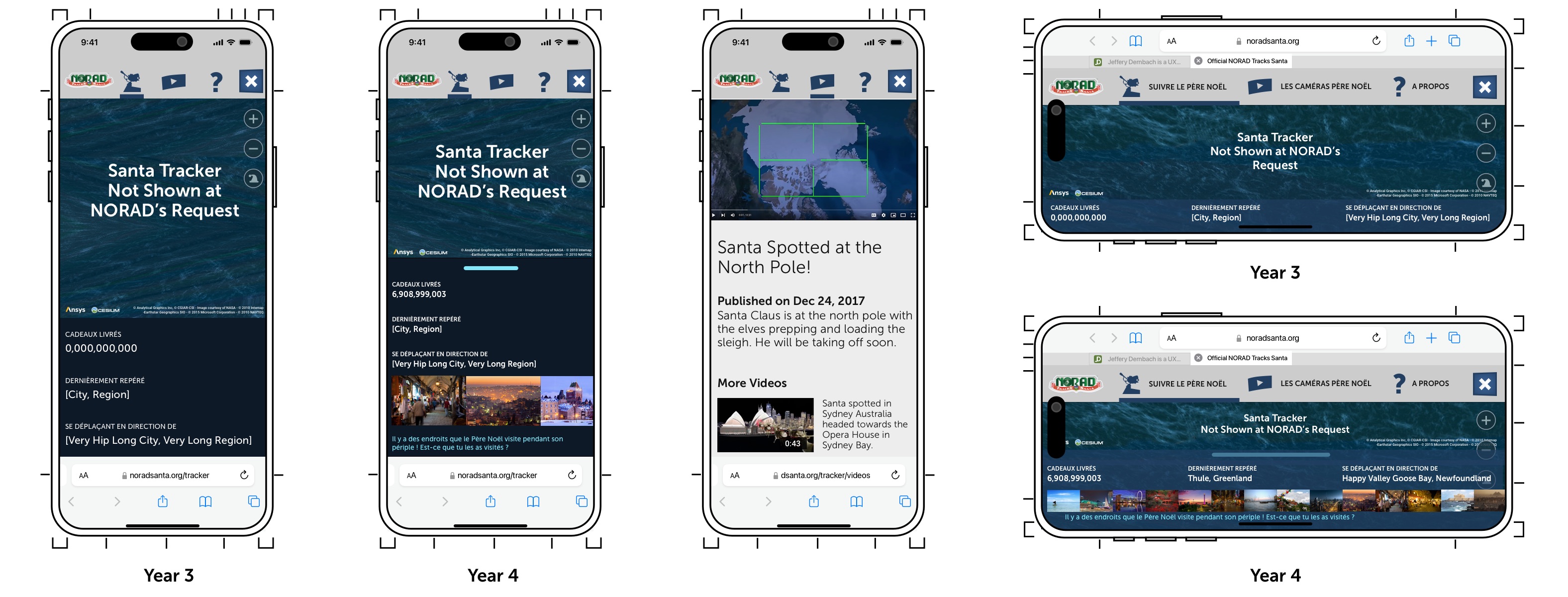
The photo carousel and the interactive geotagged locations (not shown due to NDA) on the tracker map of Santa's visits resulted in achieving the highest single day traffic to Bing in the fourth year.
Impact
Ring Out Ring Out Christmas Bells
Over the four years leading the Santa Tracking experience we recorded a net 18% gain of traffic and increased the number of page views by 5 from 2 on average visit (not considering Games and Tracker) from over 20 regions across the world. While feedback from our audience has always been extremely positive, there has been some negative feedback with certain aspects of the entire experience. When I left to pursue a new opportunity, it was with a heavy heart that I would not be able to work on this product further as I still had a roadmap of features and design ideas left on the table. I am proud of the work we accomplished each year with a tiny team and tight timeline.
- +15M
increase in total visitors in December from Y0 to Y4 - >5 mins
increase time on site and interaction with Library feature - 18%
increase in engagement with website between 2 Dec to 23 Dec from Y1 to Y4 with a 55% decrease in bounce rate. - 2
new social media platform launches that drove engagement an additional 30% to website

